The 10 Best Brian De Palma Films
Brian De Palma has become the directorial litmus test of cinephiles everywhere. To supporters, he stands as a startling visual genius with a penchant for set pieces and lurid subject matter. To naysayers, he remains a lowbrow imitator who spends his studio budgets chasing the ghosts of Alfred Hitchcock and Jean-Luc Godard. Great director or high class hack? Inconsistent misogynist or Master of the Macabre? Much like his fractured narratives, the answer is never an easy one to attain.
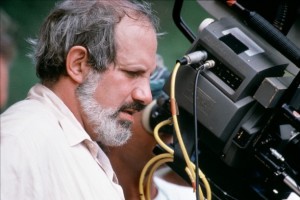
The split screen cover-up of Sisters or the heartbreaking screen tests of The Black Dahlia are breathtaking in scope and execution, shamelessly indulging the viewer in the guiltiest of pleasures. Which is usually where De Palma excels: emphasizing entertainment and suspense over highbrow art and conventional drama. If Steven Spielberg is the master of glossy all-ages spectacle, than De Palma is the connoisseur of commercially violent adult fare.
Barring a few genre exceptions (Wise Guys [1986], Mission To Mars [2000]), De Palma’s finest works shuffle between Hitchcockian thrillers and A-list studio fare. Some critics bash them, while others salivate at the mouth with cinematic awe. But through it all, from his 1968 debut Murder a la Mod to 2012’s Passion (his last theatrical release to date), De Palma has remained faithful to his unconventional vision. And with the recent festival release of Noah Baumbach and Jake Paltrow’s detailed 2015 documentary De Palma, a revisiting of his catalogue seems particularly timely.
Is Brian De Palma a great director or a high class hack? I’d say he’s both. And on an especially good day, he can meld the two traits into a hypnotic brew that few are able to match. Here are ten shining examples of when that concoction proved stronger than ever.
10. Obsession (1976)

Working with a truncated Paul Schrader script that romanticized the incestuous themes of the story, De Palma’s studio-enforced rewrites add up to a film that’s more overwrought than it is profound. Fortunately, this lack of original content is compensated with the director’s creative giddiness and technical savvy. The 360 degree transition at the graveyard introduced a stylistic trademark, while the slow-motion finale is wrapped in such melodramatic rigor that its power is undeniable. There are also some sly similarities to Nicolas Roeg’s Don’t Look Now (1973), a film that exploits its foreign settings to the same unsettling degree.
Released a year after it was completed in 1976, Obsession would land solid box office numbers and mixed reviews from critics – staking its claim as the first true “De Palma” film. Does it scale the heights of its source material? Absolutely not. Vertigo towers above Obsession in every facet imaginable, but there’s a perverse glee in watching a young filmmaker shoot for the stars without worrying what the outcome will be.
9. Snake Eyes (1998)
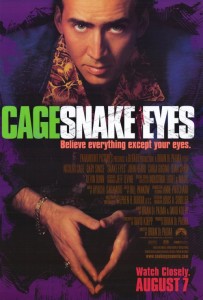
By no means does Snake Eyes view like a forgotten gem, and many of its outlandish tendencies remain the sore thumbs they were two decades ago. But the film possesses such a seedy flair for the insane that its ensemble content is anything if not entertaining. De Palma’s camerawork is in full effect here; his God’s eye view gliding over casino hotel rooms with salacious intent. And while the mysterious assassination may leave content to be desired, it’s impossible not to be caught up in the raucous Rashomon-meets-Roman Polanski set piece.
Snake Eyes is the guilty pleasure of De Palma’s oeuvre, a case where his auteur style got a little too far ahead of his substance. But hey, that doesn’t mean it’s not fun to watch.
8. Dressed to Kill (1980)
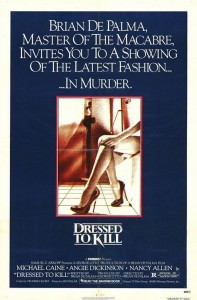
Dressed to Kill is also notable for including one of De Palma’s defining screen moments: the art museum encounter between Dickinson and her eventual killer. It’s flawlessly executed, silently floating in and out of the flirty exchange like a cinematic tango, before striking with a grisly ferocity. As one to stress the importance of geography in a suspenseful sequence, De Palma’s knack for canvas manipulation is second to none here.
The cast is great, led by Michael Caine and backed by De Palma regulars like Keith Gordon, Dennis Franz, and Mrs. De Palma herself, Nancy Allen. She got a Razzie nomination for the film, but her smutty seduction of Caine’s therapist is the stuff of erotic thriller legend.
Christened “The Master of The Macabre” on the film’s poster, De Palma was quickly becoming known for his stock-in-trade thrillers – a point driven home by the recycling of his Carrie conclusion for this film. It doesn’t ruin things, but it definitely implied some room for improvement.
7. Body Double (1984)
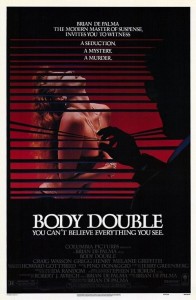
De Palma lays the Hitchcock cologne on thick with this one, but his penchant for iconic set-ups once again comes through with the power drill sequence. Frantically running across the way to rescue a doomed Gloria, Scully arrives just in time to see her hacked to bits by an “Indian” with a taste for grisly modes of murder. It’s gory, shocking, and absolutely riveting to watch. Right in the De Palma sweet spot. A spot that would also prove hugely influential on the artists of the coming decade, as director Quentin Tarantino and author Bret Easton Ellis would frequently attest to. In the case of Tarantino, De Palma’s newly acquired black humor also helps Body Double stand out from its influences, especially come the eccentric finale.
Body Double is the embodiment of a De Palma cult film: bloody, sexy, and filled to the brim with flashy Los Angeles locations. Backed by a New Wave soundtrack that keeps things deliciously dated, it prevails as the director’s most distinct interpretation of the past.
6. The Untouchables (1987)
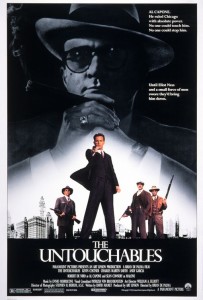
Toning down the violence and lurid erotica of his usual stuff, De Palma takes a cue from his lead character and keeps things more Saturday morning serial than Friday night after-party. Not to imply that he pulls any punches, mind you, especially when it comes to the exhilarating train station shootout. Ness and fellow “Untouchable” George Stone (Andy Garcia) wind up in a firefight on Chicago station steps as a baby stroller tumbles towards a crashing end. Clocking in at roughly ten minutes, it’s a jaw-dropping sequence that seamlessly recalls Sergei Eisenstein’s Battleship Potemkin (1915) while intermingling De Palma’s own talent for tension.
Along with being a commercial success, The Untouchables actually hit it off with critics as well, who praised the tasteful direction and memorable action scenes. In the wake of this success, De Palma would embark on a series of dramatic pieces – some received well (Casualties of War [1989]), some not so well (The Bonfire of the Vanities). But he would eventually veer back into the thriller lane with entries like Raising Cain (1992) and…
5. Mission: Impossible (1996)

From the double cross of the opening scene to the head snapping mission abort sequence, De Palma has rarely flashed such a light touch for playful action. Aided by Cruise’s firecracker performance as Ethan Hunt, the film throttles from one impossible (unavoidable pun) situation to another under the skillful eye of a director who’s clearly having a blast. It’s almost as if De Palma made the project his subtle riff on Hitchcock’s North by Northwest (1959); complete with spies, mistaken identity, and runaway trains.
But all close calls take a back seat to the glorious spectacle that is the CIA heist. Dangling from the ceiling as his IMF team barely keep it together, Hunt’s dazzlingly tense display was iconic the moment it hit theaters in 1996 – a perfect encapsulation of De Palma’s gifted storytelling.
As De Palma’s biggest blockbuster to date, the film jump started a franchise that’s still going strong at five installments. And while the director never returned for a follow-up mission, it’s telling that the series still retains his flair for international intrigue.
4. Carlito’s Way (1993)

Fortunately, De Palma never sacrifices entertainment for preachiness, dropping Carlito into a sewer of moral compromise against the pulsing nightlife of 1970s Spanish Harlem. Not since Scarface had the director so captured an era’s infectious energy, and his disco/salsa soundtrack perfectly contrasts the story’s regretful flavor. Pacino and Sean Penn (as Carlito’s coked out lawyer) are stellar in their respective roles, as is the rest of a cast that includes Penelope Ann Miller, Luis Guzman, and John Leguizamo as the sadistic Benny Blanco.
Blanco, the antithesis to everything Carlito stands for, also supplies the capper to yet another legendary train station sequence from De Palma. This time, Brigante makes a break for the Bahamas after inadvertently screwing over a few local Mafiosos, and the mad dash to make it on time results in the best action sequence ever filmed on an escalator. Guess he had to raise the bar after already using stairs in The Untouchables. And kudos to De Palma for his sly narrative homage to An Occurrence at Owl Creek Bridge (1962).
Carlito’s Way opened to so-so business and likewise critical response. Many compared it unfavorably with the earlier exploits of Tony Montana, but the film’s thoughtful approach has since solidified it as an unsung masterpiece. Much like Carlito himself, De Palma’s style showed even more depth with a little age behind it.
3. Carrie (1976)

Masterfully delivered in the guise of a teenage melodrama, the tale of Carrie White (Spacek) and her descent into madness gave the unproven director plenty of horrific fodder to play with. From the gut-punching awkwardness of the locker room opener to any of Piper Laurie’s Bible thumping monologues, De Palma brilliantly channels King’s vision and the results are unsettling to say the least. Tonally, he plays the audience like a tender ball of yarn – untethering with each subsequent flash of ESP in the face of the school’s heartless bullies (John Travolta, Nancy Allen, William Katz, and Amy Irving).
Carrie’s relatable plight (the novel’s secret weapon) is transferred to the big screen so well that even in the face of a horrifying finale, sympathy remains in her corner. Played out under the slow-motion lens of De Palma’s menacing camera, her animalistic catharsis comes to a crashing climax that’s impossible to forget once subjected to it. And I can say with a strong degree of certainty that Carrie remains the bloodiest final act ever green-lit by a Hollywood studio. That’s without even mentioning the surprise ending epilogue, which single handedly invented the jump-scare for generations to come.
The film smashed scary conventions in the face with a pail of pig blood, laying the groundwork for a legion of brutal features from the likes of Wes Craven (The Last House on the Left [1972]), John Carpenter (Halloween [1978]), and anyone else who has since tried to adapt Stephen King. De Palma, a critically acclaimed visualist for the first decade of his career, was finally awarded the praise of a filmmaker who could tell an effective story. Ironic that he would never return to the realm of King or horror, but this unforgettable contribution will always stake its claim as one of cinema’s ultimate scary movies.
2. Scarface (1983)
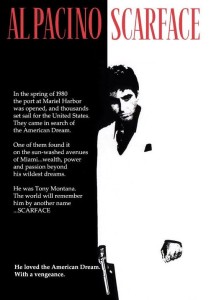
Working from an Oliver Stone script loaded with poetic obscenity, the director manipulates every angle, set-up, and tropical flourish to enhance the journey from Cuban refugee to Miami drug lord. Pacino, somehow overacting without becoming a caricature, has never been better in front of the camera, while De Palma rises to the tricky challenges behind it. Scarface was the one time he was allowed to push his violent agenda on a grand scale, and he doesn’t waste any time exploiting this opportunity. Be it the chainsaw standoff or the oh-so-quotable dismissal of Frank (Robert Loggia) and Mel Bernstein (Harris Yulin), the bold-faced De Palma is a talented kid in a candy store.
At a whopping 170-minute runtime, Scarface is De Palma’s longest film to date, yet it never feels superfluous or emotionally hollow. Tony’s various relationships, be they with Manolo (Steven Bauer), Elvira (Michelle Pfeiffer), or his sister Gina (Mary Elizabeth Mastrantonio), are handled with a tragic beauty that only serve to elevate the surface level glamour – of which there’s plenty. Encased in wide collared suits, flamboyant neons, and a killer synth soundtrack, the film’s style would maintain a stranglehold influence on the rest of the decade. There’d be no Miami Vice if it weren’t for Scarface. Especially with that sweet “Push It to the Limit” montage.
Tony’s coke fueled demise is probably the most iconic blaze of glory in movie history, and De Palma makes sure to drive this operatic point home with a literal fall from grace. Face down in his own pond with a pile of Colombian soldiers scattering the floor; one of the greatest remakes in Hollywood history comes to a close. It’s a good thing the studio went with De Palma over Sidney Lumet. Few directors have ever been so perfectly matched up with a project.
1. Blow Out (1981)
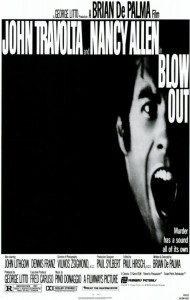
John Travolta gives a career defining performance as Jack Terry, a freelance sound designer who inadvertently captures audio evidence of a political assassination. It’s a pretty shameless take on Antonioni’s 1966 script, swapping out sight for sound, but the clarity with which De Palma delivers his split diopter story is unprecedented. Layering in allusions to Watergate and the JFK shooting on top of technically unreal moments like the 360 degree camera spin of Terry’s frantic tape search thrusts the director into rarified air; and that’s not even including the brilliant use of Philadelphia (De Palma’s hometown) as an All-American backdrop.
But in keeping with De Palma’s tumultuous tendencies, the genius of Blow Out lies just as much in what he doesn’t do as what he does do. He doesn’t take overindulgent detours that derail the plot. He doesn’t harp on violence or erotica. And most importantly, he doesn’t spend two hours chasing Hitchcock’s shadow around the set. Blow Out provides one of the few times De Palma takes hold of his own talents as a filmmaker, and the emotionally gutting conclusion rings all the more true as a result.
Incorporating slow motion, pinpoint editing, and camera virtuosity, the film’s final moments rival the power of Vertigo. Terry, a traumatized failure, returns to his trashy B-movie job and finally finds the ideal scream effect – that of the woman he couldn’t save. Its stomach churning and brutally romantic. And in this meta-cinematic conclusion, it’s everything that is brilliant about Brian De Palma.



Latest posts by Danilo Castro (see all)
- The 20 Best Detective Movies of All Time - February 16, 2016
- Life & Death: Ranking the Films of Alejandro González Iñárritu - January 6, 2016
- Evolution of a Champ: The Rocky Film Saga - November 25, 2015


